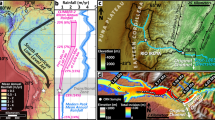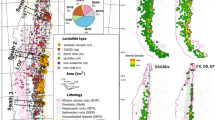Abstract
Geologic records of landslide activity offer rare glimpses into landscapes evolving under the influence of tectonics and climate. Because the deposits of individual landslides are unlikely to be preserved, landslide activity in the geologic past is often reconstructed by extrapolating from historic landslide inventories. Landslide deposits have been interpreted as palaeoclimate proxies relating to changes in precipitation, although earthquakes can also trigger landslides. Here we measure cosmogenic 10Be concentrations in individual cobbles from the modern Quebrada Veladera river channel and an adjacent terrace in Peru and calculate erosion rates. We find, in conjunction with a 10Be production model, that the 10Be concentrations of each cobble population record erosion integrated over thousands of years and are consistent with a landslide origin for the cobbles. The distribution of 10Be concentrations in terrace cobbles produced during the relatively wet climate before about 16,000 years ago is indistinguishable from the distribution in river channel cobbles produced during the drier climate of the past few thousand years. This suggests that the amount of erosion from landslides has not changed in response to climatic changes. Instead, our integrated, millennial-scale record of landslides implies that earthquakes may be the primary landslide trigger in the arid foothills of Peru.
This is a preview of subscription content, access via your institution
Access options
Subscribe to this journal
Receive 12 print issues and online access
$259.00 per year
only $21.58 per issue
Buy this article
- Purchase on Springer Link
- Instant access to full article PDF
Prices may be subject to local taxes which are calculated during checkout





Similar content being viewed by others
References
Larsen, I. J. & Montgomery, D. R. Landslide erosion coupled to tectonics and river incision. Nature Geosci. 5, 468–473 (2012).
Wieczorek, G. F. in Landslides: Investigation and Mitigation (eds Turner, A. K. & Schuster, R. L.) 76–90 (Transportation Research Board, 1996).
Paolini, L., Villalba, R. & Grau, H. R. Precipitation variability and landslide occurrence in a subtropical mountain ecosystem of NW Argentina. Dendrochronologia 22, 175–180 (2005).
Crozier, M. J. Deciphering the effect of climate change on landslide activity: A review. Geomorphology 124, 260–267 (2010).
Hermanns, R., Trauth, M. H., McWilliams, M. & Strecker, M. R. Tephrochronologic constraints on temporal distribution of large landslides in NW Argentina. J. Geol. 108, 35–52 (2000).
Trauth, M. H., Alonso, R. A., Haselton, K. R., Hermanns, R. L. & Strecker, M. R. Climate change and mass movements in the NW Argentine Andes. Earth Planet. Sci. Lett. 179, 243–256 (2000).
Keefer, D. K., Moseley, E. M. & deFrance, S. D. A 38,000-year record of floods and debris flows in the Ilo region of southern Peru and its relation to El Niño events and great earthquakes. Palaeogeog. Palaeoclimatol. Palaeoecol. 194, 41–77 (2003).
Trauth, M. H., Bookhagen, B., Marwan, N. & Strecker, M. H. Multiple landslide cluster record Quaternary climate changes in the northwestern Argentine Andes. Palaeogeog. Palaeoclimatol. Palaeoecol. 194, 109–121 (2003).
Steffen, D., Schlunegger, F. & Preusser, F. Drainage basin response to climate change in the Pisco valley, Peru. Geology 37, 491–494 (2009).
McPhillips, D., Bierman, P. R., Crocker, T. & Rood, D. H. Landscape response to Pleistocene–Holocene precipitation change in the Western Cordillera, Peru: 10Be concentrations in modern sediments and terrace fills. J. Geophys. Res. Earth Surf. 118, 1–12 (2013).
Baker, P. A. et al. Tropical climate changes at millennial and orbital timescales on the Bolivian Altiplano. Nature 409, 698–701 (2001).
Rein, B. et al. Niño variability off Peru during the last 20,000 years. Paleooceanography 20, 1–17 (2005).
Chepstow-Lusty, A. et al. Vegetation and climate change on the Bolivian Altiplano between 108,000 and 18,000 years ago. Quat. Res. 63, 90–98 (2005).
Placzek, C., Quade, J. & Patchett, P. J. Geochronology and stratigraphy of late Pleistocene lake cycles on the southern Bolivian Altiplano: Implications for causes of tropical climate change. Geol. Soc. Am. Bull. 118, 515–532 (2006).
Klein, A. G., Seltzer, G. O. & Isacks, B. L. Modern and last local glacial maximum snowlines in the Central Andes of Peru, Bolivia, and Northern Chile. Quat. Sci. Rev. 18, 63–84 (1999).
Ramage, J. M., Smith, J. A., Rodbell, D. T. & Seltzer, G. O. Comparing reconstructed Pleistocene equilibrium line altitudes in the tropical Andes of central Peru. J. Quat. Sci. 20, 777–788 (2005).
Bekaddour, T. et al. Paleo erosion rates and climate shifts recorded by Quaternary cut-and-fill sequences in the Pisco valley, central Peru. Earth Planet. Sci. Lett. 390, 103–115 (2014).
Bierman, P. R. & Nichols, K. K. Rock to sediment-slope to sea with 10Be rates of landscape change. Annu. Rev. Earth Planet. Sci. 32, 215–255 (2004).
Von Blanckenburg, F. The control mechanisms of erosion and weathering at basin scale from cosmogenic nuclides in river sediment. Earth Planet. Sci. Lett. 237, 462–479 (2005).
Codilean, A. T. et al. Single-grain cosmogenic 21Ne concentrations in fluvial sediments reveal spatially variable erosion rates. Geology 36, 159–162 (2008).
Gayer, E., Mukhopadhyay, S. & Meade, B. J. Spatial variability of erosion rates inferred from the frequency distribution of cosmogenic 3He in olivines from Hawaiian river sediments. Earth Planet. Sci. Lett. 266, 303–315 (2008).
Niemi, N., Oskin, A. M., Burbank, D. W., Heimsath, A. M. & Gabet, E. J. Effects of bedrock landslides on cosmogenically determined erosion rates. Earth Planet. Sci. Lett. 237, 480–498 (2005).
Yanites, B. J., Tucker, G. E. & Anderson, R. S. Numerical and analytical models of cosmogenic radionuclide dynamics in landslide-dominated drainage basins. J. Geophys. Res. 114, F01007 (2009).
West, A. J. et al. Dilution of 10Be in detrital quartz by earthquake-induced landslides: Implications for determining denudation rates and potential to provide insights into landslide sediment dynamics. Earth Planet. Sci. Lett. 396, 143–153 (2014).
Schaller, M. et al. A 30,000 yr record of erosion rates from cosmogenic 10Be in middle European river terraces. Earth Planet. Sci. Lett. 204, 307–320 (2002).
Balco, G., Stone, J. O., Lifton, N. A. & Dunai, T. J. A complete and easily accessible means of calculating surface exposure ages or erosion rates from 10Be and 26Al measurements. Quat. Geochronol. 3, 174–195 (2008).
Abbühl, L. M. et al. Erosion rates and mechanisms of knickzone retreat inferred from 10Be measured across strong climate gradients on the northern and central Andes Western Escarpment. Earth Surf. Process. Landf. 36, 1464–1473 (2011).
Turcotte, D. L., Malamud, B. D., Guzzetti, F. & Reichenbach, P. Self-organization, the cascade model, and natural hazards. Proc. Natl Acad. Sci. USA 99, 2530–2537 (2002).
Brunetti, M. T., Guzzetti, F. & Rossi, M. Probability distributions of landslide volumes. Nonlinear Process. Geophys. 16, 179–188 (2009).
Mettier, R., Schlunegger, F., Schneider, H., Rieke-Zapp, D. & Schwab, M. Relationships between landscape morphology, climate and surface erosion in northern Peru at 5° S latitude. Int. J. Earth Sci. 98, 2009–2022 (2009).
Rodbell, D. T. et al. An ∼ 15,000-year record of El Niño-driven alluviation in southwestern Ecuador. Science 283, 516–520 (1999).
Molnar, P. Climate change, flooding in arid environments, and erosion rates. Geology 29, 1071–1074 (2001).
Molnar, P., Anderson, R. S., Kier, G. & Rose, J. Relationships among probability distributions of stream discharges in floods, climate, bed load transport, and river incision. J. Geophys. Res. 111, F02001 (2006).
Pritchard, M. E. & Fielding, E. J. A study of the 2006 and 2007 earthquake sequence of Pisco, Peru, with InSAR and teleseismic data. Geophys. Res. Lett. 35, L09308 (2008).
Tavera, H. & Bernal, I. The Pisco (Peru) earthquake of 15 August 2007. Seismol. Res. Lett. 79, 510–515 (2008).
Malamud, B. D., Turcotte, D. L., Guzzetti, F. & Reichenbach, P. Landslides, earthquakes, and erosion. Earth Planet. Sci. Lett. 229, 45–59 (2004).
Keefer, D. K. & Moseley, M. E. Southern Peru desert shattered by the great 2001 earthquake: Implications for paleoseismic and paleo-El Niño—Southern Oscillation records. Proc. Natl Acad. Sci. USA 101, 10878–10883 (2004).
Dorbath, L., Cisternas, A. & Dorbath, C. Assessment of the size of large and great historical earthquakes in Peru. B Seismol. Soc. Am. 80, 551–576 (1990).
Keefer, D. K. The importance of earthquake-induced landslides to long-term slope erosion and slope failure in seismically active regions. Geomorphology 10, 265–284 (1994).
Xu, S., Dougans, A. B., Freeman, S. P., Schnabel, C. & Wilcken, K. M. Improved 10Be and 26Al-AMS with a 5MV spectrometer. Nucl. Instrum. Methods B 268, 736–738 (2010).
Nishiizumi, K. Absolute calibration of 10Be AMS standards. Nucl. Instrum. Methods B 258, 403–413 (2007).
Chmeleff, J., von Blanckenburg, F., Kossert, K. & Jakob, D. Determination of the 10Be half-life by multicollector ICP-MS and liquid scintillation counting. Nucl. Instrum. Methods B 268, 192–199 (2010).
Davila, M. F. (ed.) in Mapa Geologico del Cuadrangula de Guadalupe, 1:100,000 (Ministerio de Energia y Minas, Lima, 1979).
Diaz, H. S. & Landa, C. (eds) in Mapa Geologico del Cuadrangula de Tantara 1:100,000 (Ministerio de Energia y Minas, Lima, 1970).
Acknowledgements
The work was supported by National Science Foundation grant EAR-1049300 (D.M.). M. Sweeney assisted with fieldwork and analysed clast count data. N. Niemi provided a constructive review.
Author information
Authors and Affiliations
Contributions
D.M. conceived the study in collaboration with P.R.B.; D.M. wrote the manuscript, which P.R.B. and D.H.R. edited; D.M. carried out fieldwork, 10Be extraction, and modelling; P.R.B. supervised the 10Be extraction; D.H.R. performed accelerator mass spectrometry.
Corresponding author
Ethics declarations
Competing interests
The authors declare no competing financial interests.
Supplementary information
Supplementary Information
Supplementary Information (PDF 4259 kb)
Supplementary Information
Supplementary Information (XLSX 64 kb)
Rights and permissions
About this article
Cite this article
McPhillips, D., Bierman, P. & Rood, D. Millennial-scale record of landslides in the Andes consistent with earthquake trigger. Nature Geosci 7, 925–930 (2014). https://doi.org/10.1038/ngeo2278
Received:
Accepted:
Published:
Issue Date:
DOI: https://doi.org/10.1038/ngeo2278
This article is cited by
-
Cosmogenic nuclide techniques
Nature Reviews Methods Primers (2022)
-
Long-term dispersion of river gravel in a canyon in the Atacama Desert, Central Andes, deduced from their 10Be concentrations
Scientific Reports (2019)
-
Landslide-dam paleolakes in the Central Pyrenees, Upper Gállego River Valley, NE Spain: timing and relationship with deglaciation
Landslides (2018)
-
Evolution of Mass Movements near Epicentre of Wenchuan Earthquake, the First Eight Years
Scientific Reports (2016)
-
Quake, rubble and roll
Nature Geoscience (2014)



